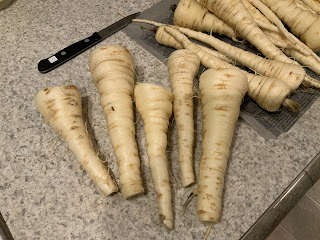 |
| Freshly harvested parsnips! |
I’m talking, of course, about parsnips. To grow them organically, you only need fairly good soil—that is, with plenty of organic matter, but no special amendments—and plant in full sun.
You’ve got a pretty wide window of sowing time too—in my experience, you can put your seeds in the ground from early May to the end of the month. Keep them watered and mulched all summer long, and you’re good to go.
You’ve got plenty of flexibility when it comes to harvesting parsnips too. I always wait until after the first frost—the roots reach their full sweetness only after a good frost. After you cut off the greens, you can toss them back on the bed for mulch and extra organic material. Keep in mind, you can continue to harvest your parsnips as needed, as long as your soil doesn’t freeze solid.
We had a mega freeze before Christmas, and the snow in our garden didn’t melt until late January. I had been out of town, and just got around to harvesting about 1/3 of the bed days ago. I roasted a big panful, and oh, were they sweet!
Hint: but don’t wait too long. I have harvested parsnips in mid-March, after the tops started growing again. Unfortunately, the roots were woody and sort of tasteless.
But when you harvest your parsnips within the optimal timeframe, the taste is incomparable! My favorite preparation is to peel the roots, cut into chunks, and drizzle with olive oil. Sprinkle a little salt on top and roast at about 360 degrees until they’re soft and golden. I also peel them for a sauté with carrots, onions, garlic and celery, then add to any kind of veggie, meat based, or bean/lentil soups.
 |
| Washed and trimmed, with good color! |
Parsnips, being a starchy vegetable, also have a leg up on other veggies without a lot of calories. Full of Vitamin C, they can add a little more robustness to your food intake—a bit like potatoes.
At our local co-op grocery, organic parsnips are $3.99/lb, and don’t look all that great. You can plant a whole bed for 4 bucks worth of seed!
Parsnips especially come in handy when you haven’t had a chance to make a trip to town for groceries, and are running low on fresh veggies.
A trip out to the garden—sure, the beds will be muddy in winter, and you might have to really put some muscle into it to work those roots out—but parsnips are well worth the effort!
No comments:
Post a Comment